[English] 日本語
 Yorodumi
Yorodumi- PDB-1mae: The Active Site Structure of Methylamine Dehydrogenase: Hydrazine... -
+ Open data
Open data
- Basic information
Basic information
| Entry | Database: PDB / ID: 1mae | ||||||
|---|---|---|---|---|---|---|---|
| Title | The Active Site Structure of Methylamine Dehydrogenase: Hydrazines Identify C6 as the Reactive Site of the Tryptophan Derived Quinone Cofactor | ||||||
 Components Components |
| ||||||
 Keywords Keywords | OXIDOREDUCTASE(CHNH2(D)-DEAMINATING) | ||||||
| Function / homology |  Function and homology information Function and homology informationmethylamine dehydrogenase (amicyanin) / methylamine dehydrogenase (amicyanin) activity / methylamine metabolic process / aliphatic amine dehydrogenase activity / amine metabolic process / outer membrane-bounded periplasmic space / periplasmic space Similarity search - Function | ||||||
| Biological species |  Paracoccus versutus (bacteria) Paracoccus versutus (bacteria) | ||||||
| Method |  X-RAY DIFFRACTION / Resolution: 2.8 Å X-RAY DIFFRACTION / Resolution: 2.8 Å | ||||||
 Authors Authors | Huizinga, E.G. / Vellieux, F.M.D. / Hol, W.G.J. | ||||||
 Citation Citation |  Journal: Biochemistry / Year: 1992 Journal: Biochemistry / Year: 1992Title: Active site structure of methylamine dehydrogenase: hydrazines identify C6 as the reactive site of the tryptophan-derived quinone cofactor. Authors: Huizinga, E.G. / van Zanten, B.A. / Duine, J.A. / Jongejan, J.A. / Huitema, F. / Wilson, K.S. / Hol, W.G. #1:  Journal: FEBS Lett. / Year: 1991 Journal: FEBS Lett. / Year: 1991Title: Crystallographic Investigations of the Tryptophan-Derived Cofactor in the Quinoprotein Methylamine Dehydrogenase Authors: Chen, L. / Mathews, F.S. / Davidson, V.L. / Huizinga, E.G. / Vellieux, F.M.D. / Duine, J.A. / Hol, W.G.J. #2:  Journal: Embo J. / Year: 1989 Journal: Embo J. / Year: 1989Title: Structure of Quinoprotein Methylamine Dehydrogenase at 2.25 Angstroms Resolution Authors: Vellieux, F.M.D. / Huitema, F. / Groendijk, H. / Kalk, K.H. / Frank, J. / Jongejan, J.A. / Duine, J.A. / Petratos, K. / Drenth, J. / Hol, W.G.J. #3:  Journal: Eur.J.Biochem. / Year: 1986 Journal: Eur.J.Biochem. / Year: 1986Title: Purification, Crystallization and Preliminary X-Ray Investigation of Quinoprotein Methylamine Dehydrogenase from Thiobacillus Versutus Authors: Vellieux, F.M.D. / Frank, J. / Swarte, M.B.A. / Groendijk, H. / Duine, J.A. / Drenth, J. / Hol, W.G.J. | ||||||
| History |
|
- Structure visualization
Structure visualization
| Structure viewer | Molecule:  Molmil Molmil Jmol/JSmol Jmol/JSmol |
|---|
- Downloads & links
Downloads & links
- Download
Download
| PDBx/mmCIF format |  1mae.cif.gz 1mae.cif.gz | 53.3 KB | Display |  PDBx/mmCIF format PDBx/mmCIF format |
|---|---|---|---|---|
| PDB format |  pdb1mae.ent.gz pdb1mae.ent.gz | 35.3 KB | Display |  PDB format PDB format |
| PDBx/mmJSON format |  1mae.json.gz 1mae.json.gz | Tree view |  PDBx/mmJSON format PDBx/mmJSON format | |
| Others |  Other downloads Other downloads |
-Validation report
| Summary document |  1mae_validation.pdf.gz 1mae_validation.pdf.gz | 383 KB | Display |  wwPDB validaton report wwPDB validaton report |
|---|---|---|---|---|
| Full document |  1mae_full_validation.pdf.gz 1mae_full_validation.pdf.gz | 389.3 KB | Display | |
| Data in XML |  1mae_validation.xml.gz 1mae_validation.xml.gz | 5.2 KB | Display | |
| Data in CIF |  1mae_validation.cif.gz 1mae_validation.cif.gz | 11.1 KB | Display | |
| Arichive directory |  https://data.pdbj.org/pub/pdb/validation_reports/ma/1mae https://data.pdbj.org/pub/pdb/validation_reports/ma/1mae ftp://data.pdbj.org/pub/pdb/validation_reports/ma/1mae ftp://data.pdbj.org/pub/pdb/validation_reports/ma/1mae | HTTPS FTP |
-Related structure data
- Links
Links
- Assembly
Assembly
| Deposited unit | 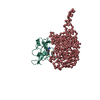
| ||||||||
|---|---|---|---|---|---|---|---|---|---|
| 1 | 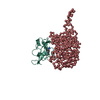
| ||||||||
| Unit cell |
| ||||||||
| Details | THE MOLECULE IS NORMALLY A TETRAMER. THE CRYSTALLOGRAPHIC ASYMMETRIC UNIT CONSISTS OF ONE-HALF OF THE TETRAMER, NAMELY ONE LIGHT CHAIN *L* AND ONE HEAVY CHAIN *H*. TO GENERATE THE FULL MOLECULE, THE FOLLOWING CRYSTALLOGRAPHIC TWO-FOLD OPERATION MUST BE APPLIED TO THE LIGHT AND HEAVY CHAINS PRESENTED IN THIS ENTRY -0.5 0.866025 0.0 0.0 0.866025 0.5 0.0 0.0 0.0 0.0 -1.0 208.368 |
- Components
Components
| #1: Protein | Mass: 13654.172 Da / Num. of mol.: 1 Source method: isolated from a genetically manipulated source Source: (gene. exp.)  Paracoccus versutus (bacteria) / References: UniProt: P22641, EC: 1.4.99.3 Paracoccus versutus (bacteria) / References: UniProt: P22641, EC: 1.4.99.3 |
|---|---|
| #2: Protein | Mass: 38031.996 Da / Num. of mol.: 1 Source method: isolated from a genetically manipulated source Source: (gene. exp.)  Paracoccus versutus (bacteria) / References: UniProt: P23006, EC: 1.4.99.3 Paracoccus versutus (bacteria) / References: UniProt: P23006, EC: 1.4.99.3 |
| #3: Chemical | ChemComp-HDZ / |
| #4: Water | ChemComp-HOH / |
| Compound details | THE L SUBUNIT CONTAINS THE SIDE CHAIN DERIVED COFACTOR TRYPTOPHYL TRYTOPHAN-QUINONE (MCINTYRE ET AL. ...THE L SUBUNIT CONTAINS THE SIDE CHAIN DERIVED COFACTOR TRYPTOPHYL |
| Sequence details | FOR THE H-SUBUNIT THE SEQUENCE GIVEN IN THE SEQRES RECORDS IS AN *X-RAY SEQUENCE*, WHICH WAS ...FOR THE H-SUBUNIT THE SEQUENCE GIVEN IN THE SEQRES RECORDS IS AN *X-RAY SEQUENCE*, WHICH WAS ESTABLISHE |
-Experimental details
-Experiment
| Experiment | Method:  X-RAY DIFFRACTION X-RAY DIFFRACTION |
|---|
- Sample preparation
Sample preparation
| Crystal | Density Matthews: 4.91 Å3/Da / Density % sol: 74.93 % | |||||||||||||||||||||||||
|---|---|---|---|---|---|---|---|---|---|---|---|---|---|---|---|---|---|---|---|---|---|---|---|---|---|---|
| Crystal grow | *PLUS Temperature: 4 ℃ / pH: 5 / Method: vapor diffusion, hanging dropDetails: taken from Ubbink, M. et al (1991). Eur. J. Biochem., 202, 1003-1012. | |||||||||||||||||||||||||
| Components of the solutions | *PLUS
|
-Data collection
| Radiation | Scattering type: x-ray |
|---|---|
| Radiation wavelength | Relative weight: 1 |
| Reflection | *PLUS Highest resolution: 2.8 Å / Num. obs: 25377 / % possible obs: 95.7 % / Num. measured all: 125106 / Rmerge(I) obs: 0.073 |
| Reflection shell | *PLUS % possible obs: 92.4 % / Rmerge(I) obs: 0.157 |
- Processing
Processing
| Software | Name: TNT / Classification: refinement | ||||||||||||||||||||||||||||||
|---|---|---|---|---|---|---|---|---|---|---|---|---|---|---|---|---|---|---|---|---|---|---|---|---|---|---|---|---|---|---|---|
| Refinement | Rfactor obs: 0.183 / Highest resolution: 2.8 Å Details: ALTHOUGH CLEAR EXTRA DENSITY WAS OBSERVED IN THE ACTIVE SITE, SUFFICIENT DENSITY WAS NOT PRESENT TO ACCOMMODATE THE COMPLETE INHIBITOR (FOR DETAILS SEE ARTICLE SPECIFIED IN REFERENCE 1). TWO ...Details: ALTHOUGH CLEAR EXTRA DENSITY WAS OBSERVED IN THE ACTIVE SITE, SUFFICIENT DENSITY WAS NOT PRESENT TO ACCOMMODATE THE COMPLETE INHIBITOR (FOR DETAILS SEE ARTICLE SPECIFIED IN REFERENCE 1). TWO ATOMS OF THE INHIBITOR (MHZ), TENTATIVELY IDENTIFIED AS NITROGENS HAVE BEEN INCLUDED IN THE MODEL AS HDZ. | ||||||||||||||||||||||||||||||
| Refinement step | Cycle: LAST / Highest resolution: 2.8 Å
| ||||||||||||||||||||||||||||||
| Refine LS restraints |
|
 Movie
Movie Controller
Controller



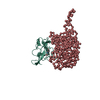
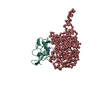

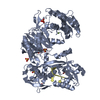
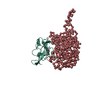
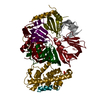
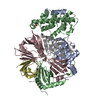
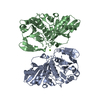
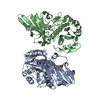
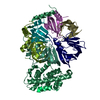
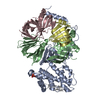
 PDBj
PDBj


